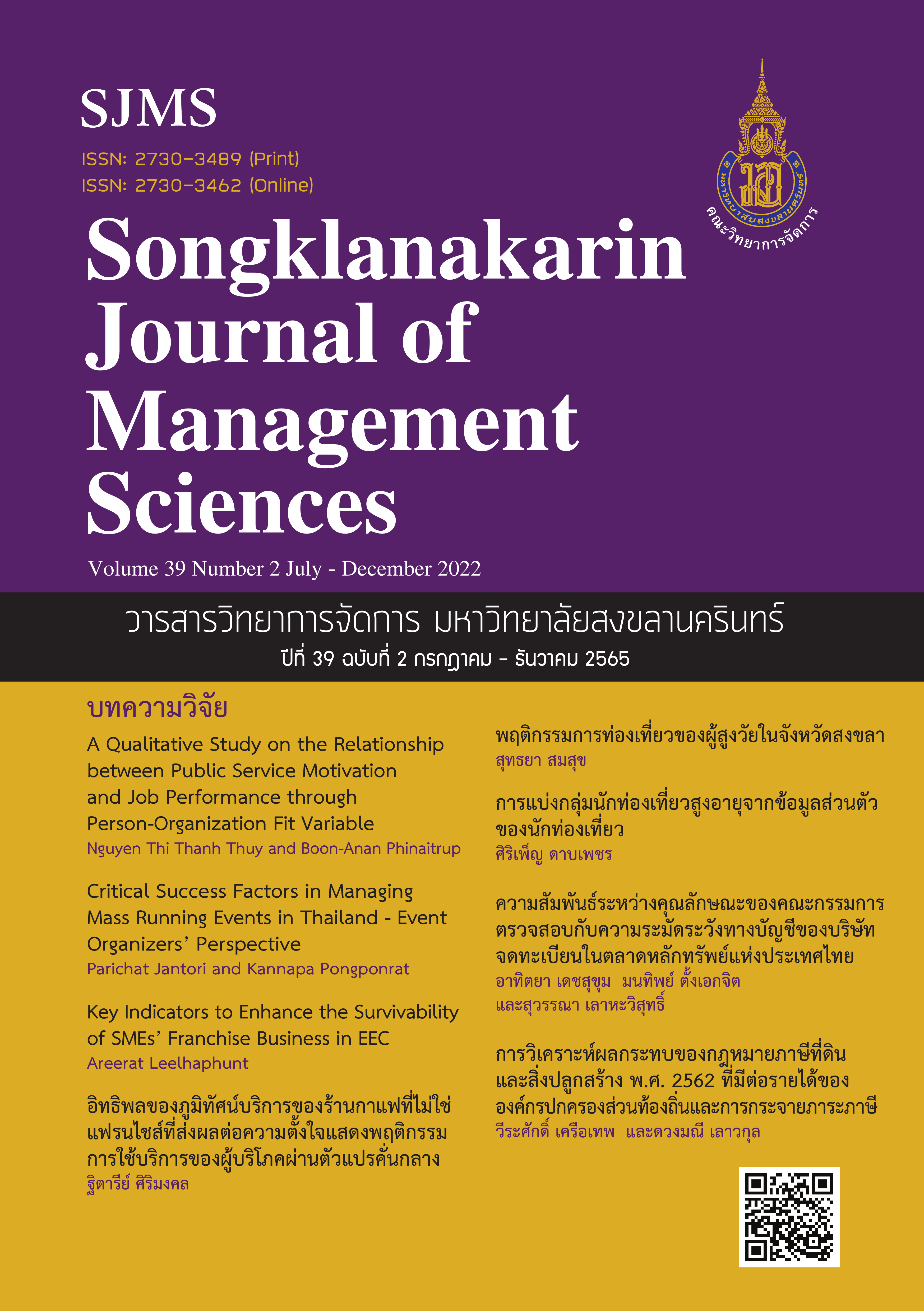การศึกษาเชิงคุณภาพของความสัมพันธ์ระหว่างแรงจูงใจในการบริการสาธารณะและผลการปฏิบัติงานผ่านตัวแปรความสอดคล้องระหว่างบุคคลกับองค์การ
Main Article Content
บทคัดย่อ
แรงจูงใจในการบริการสาธารณะ คือ มุมมองและความตั้งใจของปัจเจกบุคคลที่จะทำความดีเพื่อผู้อื่นและสังคม แรงจูงใจดังกล่าวนี้ถูกคาดหวังว่าจะช่วยเพิ่มประสิทธิภาพของผู้ปฏิบัติงานในองค์การสาธารณะ ขณะที่ความสอดคล้องระหว่างบุคคลและองค์การก็ได้รับการสันนิษฐานว่า จะเป็นสื่อกลางความเชื่อมโยงระหว่างแรงจูงใจและประสิทธิภาพการปฏิบัติงานดังกล่าว การวิจัยนี้มีวัตถุประสงค์เพื่อวิเคราะห์ความเชื่อมโยงระหว่างแรงจูงใจในการบริการสาธารณะกับผลการปฏิบัติงานจากอิทธิพลการส่งผ่านของตัวแปรความสอดคล้องระหว่างบุคคลและองค์การ โดยใช้การวิจัยเชิงคุณภาพซึ่งเก็บรวบรวมข้อมูลโดยการสัมภาษณ์เชิงลึกจากผู้ให้ข้อมูล จำนวน 8 ท่าน ได้แก่ ประธานผู้บริหารชายและประธานผู้บริหารหญิงของคณะกรรมการประชาชนนครโฮจิมินห์ 2 ท่าน รองประธานฝ่ายกฎหมาย 2 ท่าน หัวหน้าแผนกฝ่ายกฎหมาย 2 ท่าน และผู้อำนวยการฝ่ายกฎหมาย 2 ท่าน จากองค์การสาธารณะภายใต้การกำกับดูแลของคณะกรรมการประชาชนนครโฮจิมินห์ ประเทศเวียดนาม และทำการวิเคราะห์ข้อมูลด้วยวิธีวิเคราะห์แก่นสาระ ซึ่งผลการวิจัยพบว่า แรงจูงใจในการบริการสาธารณะมีบทบาทสำคัญในการเพิ่มประสิทธิภาพของผู้ปฏิบัติงานในภาครัฐ และตัวแปรความสอดคล้องระหว่างบุคคลและองค์การมีอิทธิพลเป็นอย่างมากต่อความสัมพันธ์ดังกล่าว ทั้งนี้ ผลการวิจัยนี้จะช่วยให้ผู้บริหารเพิ่มโอกาสในการเสริมสร้างแรงจูงใจในการบริการสาธารณะมากขึ้นอันจะช่วยพัฒนาผลการปฏิบัติงานได้อย่างมีประสิทธิภาพ
Article Details

อนุญาตภายใต้เงื่อนไข Creative Commons Attribution-NonCommercial-NoDerivatives 4.0 International License.
บทความที่ตีพิมพ์ถือเป็นลิขสิทธิ์ของวารสารวิทยาการจัดการ มหาวิทยาลัยสงขลานครินทร์ อย่างไรก็ตาม กองบรรณาธิการไม่สงวนลิขสิทธิ์ในการทำซ้ำ คัดลอก หรือเผยแพร่ แต่จะต้องอ้างอิงให้ถูกต้องตามหลักวิชาการ
เอกสารอ้างอิง
Alonso, P., & Lewis, G. B. (2001). Public service motivation and job performance evidence from the federal sector. American Review of Public Administration, 31(4), 363-380.
Andersen, L. B., Heinesen, E., & Pedersen, L. H. (2012). How does public service motivation affect performance in schools? 2012 APPAM Conference, 1-53.
Andersen, L. B., & Serritzlew, S. (2012). Does public service motivation affect the behavior of professionals? International Journal of Public Administration, 35(1), 19-29. https://doi.org/10.1080/01900692.2011.635277
Boyne, G., & Dahya, J. (2002). Executive succession and the performance of public organizations. Public Administration, 80(1), 179-200. https://doi.org/10.1111/1467-9299.00299
Brewer, G. A., & Selden, S. C. (2000). Why Elephants Gallop : Assessing and predicting organizational performance in federal agencies. Journal of Public Administration Research and Theory, 10(4), 685-711.
Bright, L. (2007). Does person-organization fit mediate the relationship between public service motivation and the job performance of public employees? Review of Public Personnel Administration, 27(4), 361-379. https://doi.org/10.1177/0734371X07307149
Cable, D. M., & DeRue, D. S. (2002). The convergent and discriminant validity of subjective fit perceptions. Journal of Applied Psychology, 87(5), 875-884. https://doi.org/10.1037/0021-9010.87.5.875
Christensen, R. K., & Wright, B. E. (2011). The effects of public service motivation on job choice decisions: Disentangling the contributions of person-organization fit and person-job fit. Journal of Public Administration Research and Theory, 21(4), 723-743.
Creswell, J. (2014). Qualitative inquiry & research design: Choosing among five approaches. Thousand Oaks, CA: Sage. https://doi.org/10.13187/rjs.2017.1.30
Crum, J., & Naff, K. (1999). Working for America: Does public service motivation make a difference? Review of Public Personnel Administration, 19(4), 5-16.
Fried, S., Warsame, A. M., Berggren, V., Isman, E., & Johansson, A. (2013). Outpatients’ perspectives on problems and needs related to female genital mutilation/cutting: A qualitative study from Somaliland. Obstetrics and Gynecology International, 2013(September), 1-11. https://doi.org/10.1155/2013/165893
Gould-Williams, J. S., Mostafa, A. M. S., & Bottomley, P. (2015). Public service motivation and employee outcomes in the egyptian public sector: Testing the mediating effect of person-organization fit. Journal of Public Administration Research and Theory, 25(2), 597-622. https://doi.org/10.1093/jopart/mut053
Guest, G., Bunce, A., & Johnson, L. (2006). How many interviews are enough?: An experiment with data aaturation and variability. Field Methods, 18(1), 59-82. https://doi.org/10.1177/1525822X05279903
Jin, M. H., McDonald, B., & Park, J. (2018). Does public service motivation matter in public higher education? Testing the theories of person-organization fit and organizational commitment through a serial multiple mediation model. American Review of Public Administration, 48(1), 82-97. https://doi.org/10.1177/0275074016652243
Kim, S. (2012). Does person-organization fit matter in the public sector? Testing the mediating effect of person-organization fit in the relationship between public service motivation and work attitudes. Public Administration Review, 72(6), 830-840. https://doi.org/10.1111/j.1540-6210.2012.02572.x
Kim, S. (2016). Job Characteristics, public service motivation, and work performance in Korea. Gestion et Management Public, 5(1), 7-24. https://doi.org/10.3917/gmp.051.0007
Kim, T. -Y., Aryee, S., Loi, Raymond, & Kim, S. (2013). Person-organization fit and employee outcomes: Test of a social exchange model. The International Journal of Human Resource Management, 24(19), 3719-3737. https://doi.org/10.1080/09585192.2013.781522
Leisink, P., & Steijn, B. (2009). Public service motivation and job performance of public sector employees in the Netherlands. International Review of Administrative Sciences, 75(1), 35-52. https://doi.org/10.1177/0020852308099505
Loon, N. M. (2016). Is public service motivation related to overall and dimensional work-unit performance as indicated by supervisors? International Public Management Journal, 19(1), 78-110. https://doi.org/10.1080/10967494.2015.1064839
Lynggaard, M., Pedersen, M. J., & Andersen, L. B. (2018). Exploring the context dependency of the PSM-performance relationship. Review of Public Personnel Administration, 38(3), 332-354. https://doi.org/10.1177/0734371X16671371
Nicola Belle. (2013). Experimental evidence on the relationship between public service motivation and job performance. Public Administration Review, 73(1), 143-153. https://doi.org/10.111/j.1540-6210.2012.02621.x.Experimental
Palma, R. (2016). Public service motivation and employee outcomes in the Italian public sector: Testing the mediating effect of person-organization fit. Journal of Applied Quantitative Methods, 11(2), 1-16.
Park, S. M., & Rainey, H. G. (2008). Leadership and public service motivation in U.S. federal agencies. International Public Management Journal, 11(1), 109-142. https://doi.org/10.1080/10967490801887954
Perry, J. L., & Hondeghem, A. (2008). Building theory and empirical evidence about public service motivation. International Public Management Journal, 11(1), 3-12. https://doi.org/10.1080/10967490801887673
Perry, J. L., & Wise, L. R. (1990). The motivational bases of public service. Public Administration Review, 50(3), 367-373. https://doi.org/10.2307/976618
Perry, J. L., & Wise, L. R. (2010). Revisiting the motivational bases of public service: Twenty years of research and an agenda for the future. Public Administration Review, 70(5), 681-690. https://doi.org/doi.org/10.1111/j.1540-6210.2010.02196.x
Sangmook, K. (2006). Public service motivation and organizational citizenship behavior in Korea. International Journal of Manpower, 27(8), 722-740. https://doi.org/10.1108/01437720610713521
Stake, R. E. (2010). Qualitative research: Studying how things work. In New York, NY: Guilford Publications, Inc.
Vandenabeele, W. (2009). The mediating effect of job satisfaction and organizational commitment on self-reported performance: More robust evidence of the PSM - Performance relationship. International Review of Administrative Sciences, 75(1), 11-34. https://doi.org/10.1177/0020852308099504
Yin, R. (2014). Case study research: Design and methods. In Thousand Oaks, CA: Sage. (Issue 2014). https://doi.org/10.3138/CJPE.BR-240

